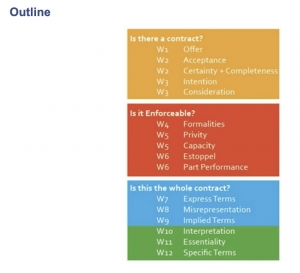LLB202 Contract Law Notes
Summary:
Contract Law offers a structured insight into the formation and execution of agreements. Starting with basic terminologies, the focus shifts to the essence of an offer, distinguishing between unilateral and bilateral agreements, and outlining what doesn’t qualify as an offer. This is complemented by understanding the nuances of acceptance, ranging from intention to electronic transaction specifics. The intricacies of contract certainty, intention in various relational contexts, and the pivotal role of consideration are elaborated upon. The note sheds light on formal requirements, especially concerning land and guarantees, and navigates the complexities of capacity, touching upon the implications of age and mental health. The doctrine of privity, its exceptions, and the pivotal concept of estoppel, are discussed, along with the nuances of part performance, express terms, oral representations, and the ramifications of misrepresentation. Special emphasis is given to implied terms, exploring them from varied angles, including intention, custom, and law. Interpretative techniques, the significance of essential terms, exclusion clauses, and the restraint of trade are dissected. The discourse concludes with a review, encapsulating core contractual principles and elements, serving as an invaluable guide to the multifaceted world of contract law.
Excerpt:
LLB202 Contract Law Notes

LLB202 Contract Law Notes
1. Terminology
• Promisor and Promisee
o This can flow & shift with each case
• To define something: start by finding a case. If there is no case, then a textbook, and then a dictionary
o Use a legal dictionary
2. Offer
• Offer + Acceptance = Agreement
• It is not necessary to determine the precise offer and acceptance
• Must be communicated
• This can be between 2 or more parties → Clarke v Dunraven [1847] AC 59
What is an offer?
• “An offer is the expression to another of a willingness to be legally bound by the stated terms.” → Per Textbook [3.25]
• Key factors:
o Expression → words, directions, statements – made to another
o To another
o Legally bound
o Stated terms
Unilateral & Bilateral Agreements
- Bilateral
• 2 parties need to act on promises
• Exchange of promises - Unilateral
• Acceptance is the performance of the contract
• Then only one promise left to resolve
• What happens after – how many promises left to be resovled?
• Example: finding a lost dog


Reviews